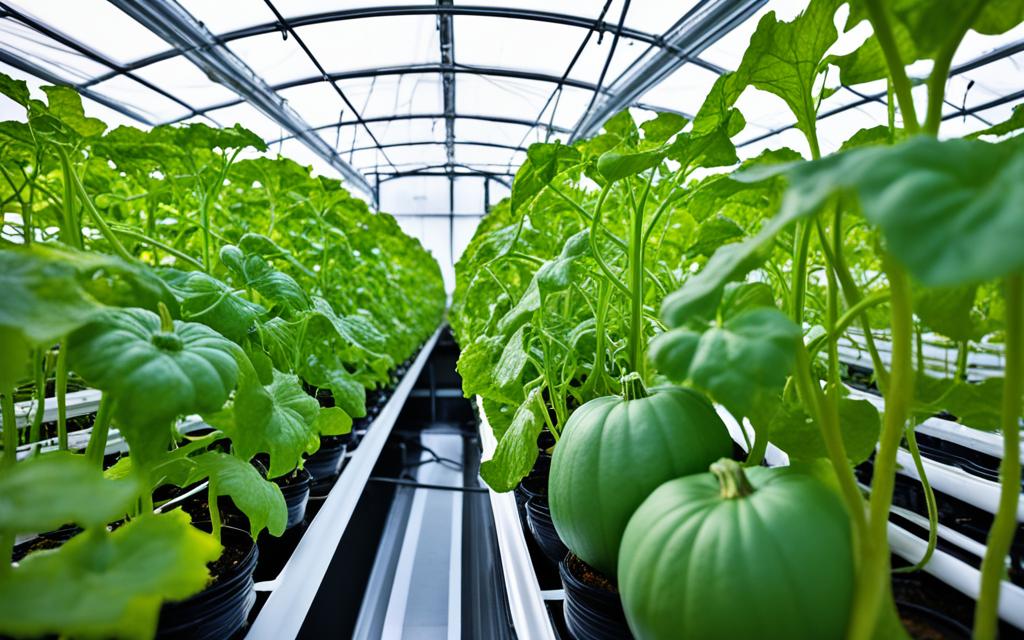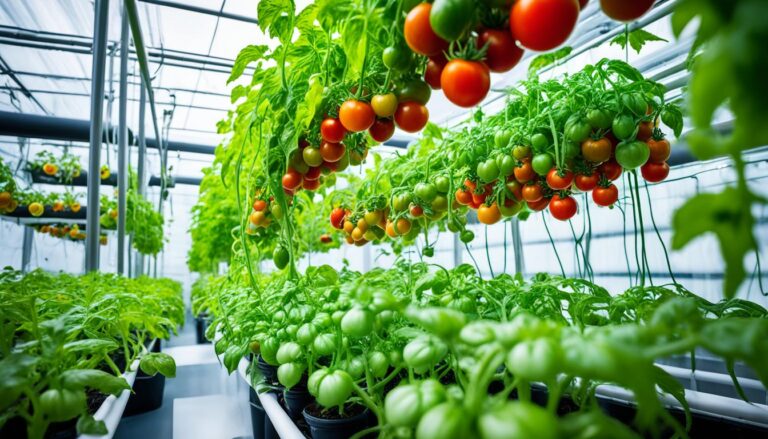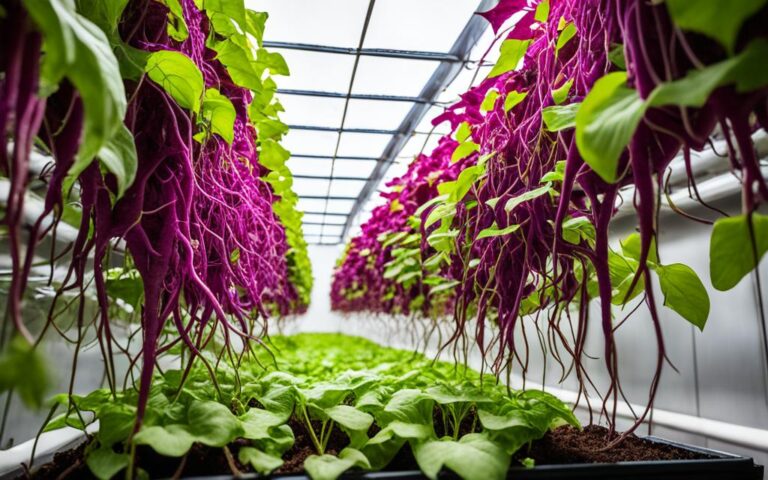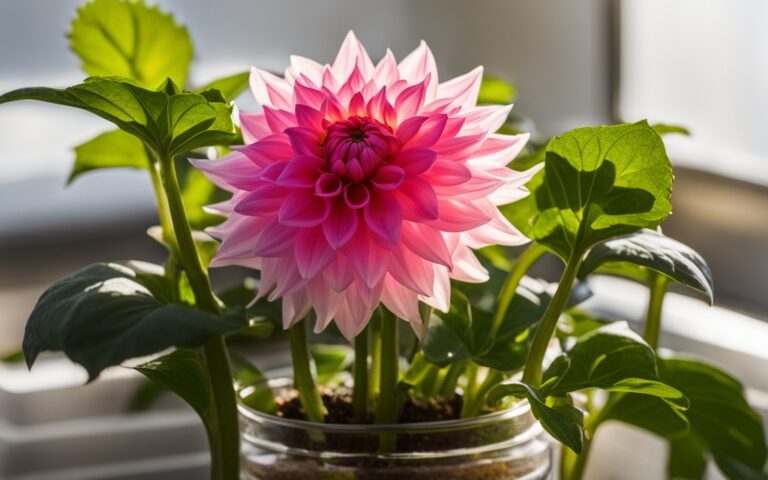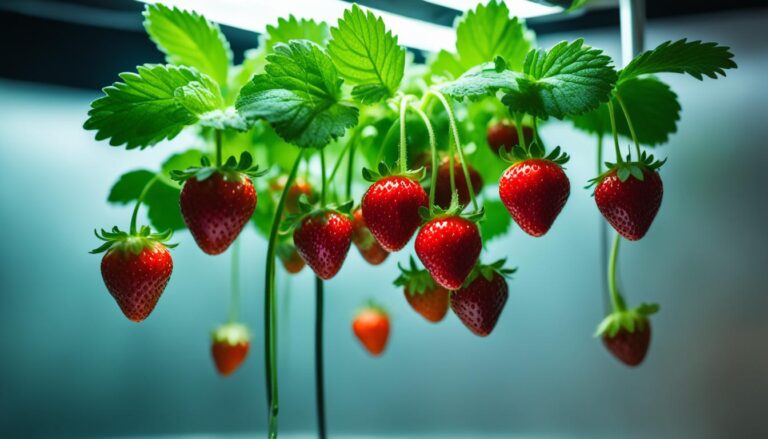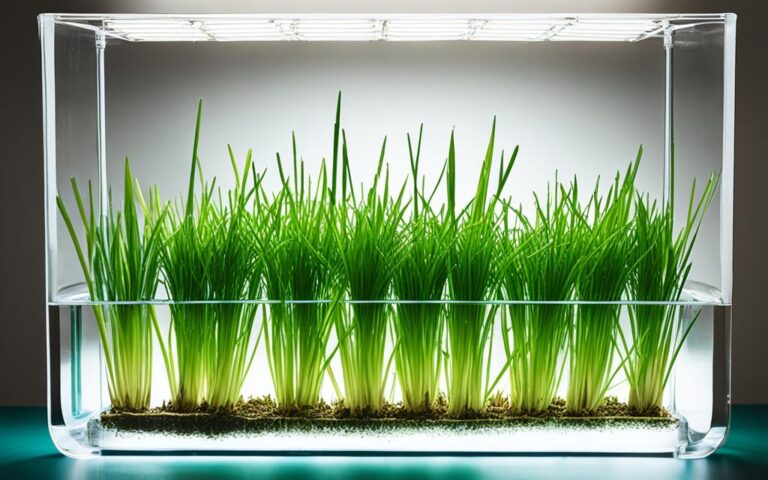Grow Hydroponic Pumpkin: Innovative Farming Tips
Did you know hydroponic pumpkins can grow up to 50% more than those grown in soil? This new way of farming is changing how we grow pumpkins. It uses water to give plants nutrients, making growing conditions better and increasing harvests.
Key Takeaways
- Hydroponic pumpkin cultivation can increase yields by up to 50% compared to traditional soil-based methods.
- The Deep Water Culture (DWC) system is the most suitable hydroponic setup for growing pumpkins, providing ample root space and nutrient solution.
- Maintaining the right temperature, light, pH, and nutrient levels is crucial for successful hydroponic pumpkin cultivation.
- Careful monitoring and management of pests and diseases are essential to ensure a healthy and bountiful hydroponic pumpkin crop.
- Selecting the right pumpkin variety for hydroponic growing can enhance productivity and fruit quality.
Introduction to Hydroponic Pumpkin Cultivation
The art of growing pumpkins hydroponically is exciting in modern farming. Hydroponic systems change how we grow this versatile fruit. They help growers get more from their land and make growing easier. Unlike old ways, hydroponic pumpkin farming uses controlled settings, exact nutrients, and saves water.
Hydroponic farming is a green way to solve old farming problems. It works well in many places, from city rooftops to greenhouses. This method lets farmers produce more, use resources better, and harm the environment less. It’s a great choice for today’s farms.
As the world needs more food and land gets scarce, hydroponic pumpkin farming is key. It uses hydroponics to make growing pumpkins sustainable and efficient. This helps with food security and taking care of our planet.
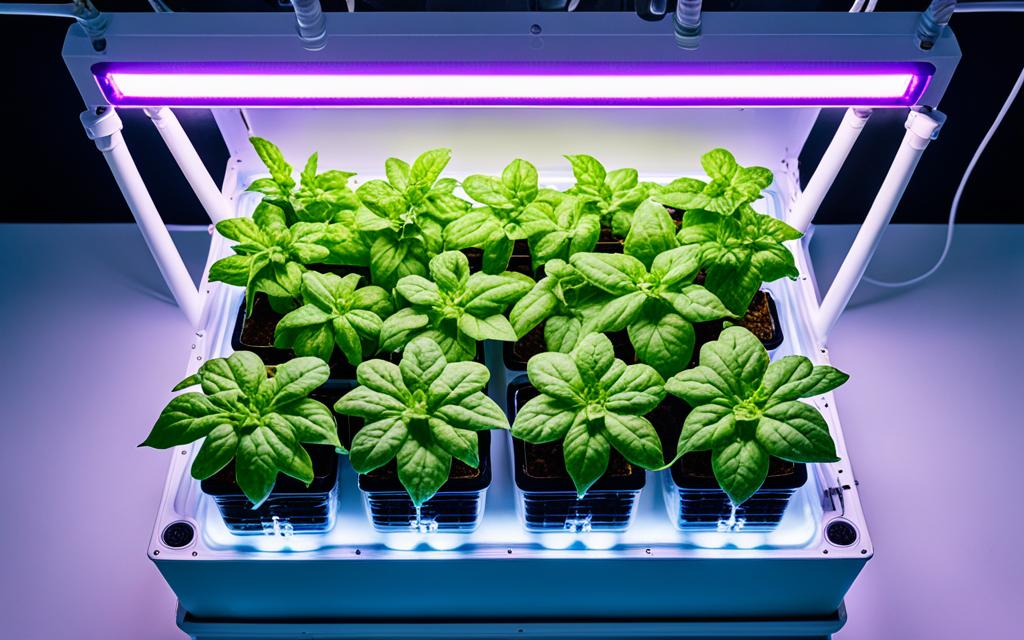
“Hydroponics offers a revolutionary approach to growing pumpkins, allowing growers to maximize yields and streamline the cultivation process.”
Selecting the Right Hydroponic System
Choosing the right hydroponic system is key when growing pumpkins. They need a lot of space and specific water and nutrients. The Deep Water Culture (DWC) system is perfect for hydroponic pumpkins.
Deep Water Culture System Ideal for Pumpkins
The DWC system gives pumpkins a big root space and a big reservoir for nutrients. This is crucial for their growth. The roots stay in a nutrient-rich water solution, giving them all they need to grow well.
Other systems like the Nutrient Film Technique (NFT) aren’t good for pumpkins. Their narrow channels and shallow water can get blocked by the pumpkin’s roots. This can lead to problems with getting nutrients and water.
| Hydroponic System | Suitability for Pumpkins |
|---|---|
| Deep Water Culture (DWC) | Ideal for pumpkins due to the large root space and nutrient solution reservoir |
| Nutrient Film Technique (NFT) | Not well-suited for pumpkins as the narrow channels can easily become clogged by the extensive root system |
Choosing the best hydroponic system for pumpkin cultivation is important. It ensures your hydroponic pumpkin DWC setup is perfect for healthy growth and lots of pumpkins. This is key to managing a successful hydroponic pumpkin system.
Starting from Seeds vs. Transplants
Growing hydroponic pumpkins can be done from either hydroponic pumpkin seeds or hydroponic pumpkin transplants. Each method has its own benefits and things to consider.
Starting with seeds lets you control the plant’s growth closely. You can pick varieties that resist diseases well for hydroponics. But, it takes more time and effort, as you must watch over the seedlings closely.
On the other hand, hydroponic pumpkin transplants are faster. They’re good for those who are busy or have little space. But, make sure the plants adjust well to the hydroponic setup to prevent stress.
| Starting from Seeds | Using Transplants |
|---|---|
|
|
Whether you start with seeds or transplants, pick varieties that fight diseases well for hydroponics. With the right method and care, you can get a lot of tasty hydroponic pumpkins.
Hydroponic Pumpkin Nutrients and pH Requirements
Growing pumpkins hydroponically means you need to pay close attention to nutrients and pH levels. Pumpkins need a lot of nutrients to grow well in a hydroponic setup. It’s important to get the nutrient balance right and keep the pH levels just right for a good harvest.
Essential Nutrients for Optimal Growth
The main nutrients pumpkins need are nitrogen, phosphorus, and potassium. But, they also need calcium, magnesium, and iron for good health and growth. Getting the right mix of these nutrients is key for hydroponic pumpkin growth.
Maintaining Ideal pH and TDS/EC Levels
- Keep the pH of the nutrient solution between 6.0 to 6.8. This range helps pumpkins absorb nutrients well.
- Check the Total Dissolved Solids (TDS) and Electrical Conductivity (EC) levels. For hydroponic pumpkins, TDS should be 800 to 1,200 ppm, and EC should be 1.6 to 2.4 mS/cm.
By managing the hydroponic pumpkin nutrients, pH, TDS, and EC well, growers can create the best environment for their pumpkins. This leads to strong growth, healthy leaves, and lots of fruit.
Light and Temperature Needs for Hydroponic Pumpkin
Growing hydroponic pumpkins needs a balance of light and temperature for best growth. Pumpkins do well with lots of sunlight, needing at least 8 hours of direct light daily. This can come from the sun or hydroponic pumpkin light requirements supplements.
The best hydroponic pumpkin temperature is between 65°F to 95°F. As fall gets cooler, you might need to bring your hydroponic setup inside. This keeps the temperature right for growing pumpkins hydroponically indoors.
| Light Requirement | Temperature Requirement |
|---|---|
| 8+ hours of direct light per day | 65°F to 95°F |
Getting the right mix of light and temperature is key for healthy hydroponic pumpkins. By watching these factors closely, growers can make sure their plants do well.
Hydroponic Pumpkin Growth Stages
Growing pumpkins hydroponically means managing their growth stages well. It’s key to know these stages for the best growing conditions and high yields.
Seedling and Vegetative Growth
The hydroponic pumpkin seedling stage is very important. Young plants need careful watching of the nutrient solution, pH, and temperature. This ensures they grow healthy.
As they grow, they start to build a strong root system and grow big, green leaves.
Flowering and Fruit Set
When hydroponic pumpkins start flowering and setting fruit, they need support. Using the right hydroponic pumpkin flowering and hydroponic pumpkin fruit set methods helps. This includes pruning and training to get the most from your plants.
| Growth Stage | Key Considerations |
|---|---|
| Seedling |
|
| Vegetative |
|
| Flowering and Fruit Set |
|
Knowing and managing the hydroponic pumpkin growth stages helps growers create the best environment. This way, plants can thrive and give big harvests.
Maximizing Yield and Fruit Size
To get a great hydroponic pumpkin harvest and big hydroponic pumpkin fruit size, focus on the best growing conditions. Give them the right nutrients, keep the pH and EC levels perfect, and manage light and temperature well. This way, hydroponic pumpkin growers can make the most of their crops.
Pruning and training your plants is a smart move for growing larger hydroponic pumpkins. Cut back on extra leaves and direct the plant’s energy to making bigger pumpkins. Using trellises or cages helps keep the heavy pumpkins from breaking the vines.
| Factors for Maximizing Hydroponic Pumpkin Yield and Fruit Size | Recommended Ranges |
|---|---|
| Nutrient Levels | N: 100-150 ppm, P: 40-60 ppm, K: 150-200 ppm |
| pH | 5.8 – 6.5 |
| EC/TDS | 1.8 – 2.2 mS/cm (1200 – 1500 ppm) |
| Temperature | 70-85°F (21-29°C) |
| Light Exposure | 12-14 hours per day |
Keep an eye on your plants and adjust their environment as needed. This way, hydroponic pumpkin growers can boost their hydroponic pumpkin yield and get big hydroponic pumpkin fruit size.
“With the right combination of hydroponics, pumpkins can reach impressive sizes and yields that surpass traditional field-grown methods.”
Hydroponic Pumpkin Pruning and Training
Proper pruning and training are key for growing big, quality hydroponic pumpkins. It’s important to trim the plants to remove extra leaves or fruit. This lets the plant focus on the pumpkins it should grow. Also, using support like trellises helps the pumpkins grow big without getting damaged or diseased.
Techniques for Growing Large Hydroponic Pumpkins
To get the most out of your hydroponic pumpkins, try these hydroponic pumpkin pruning and training tips:
- Trim off leaves or shoots that don’t help the main pumpkin grow. This makes the plant work harder on the big fruit.
- Use trellises or cages to keep pumpkins off the ground. This stops rot and damage, and helps the plant put more energy into the fruit.
- Guide the vines to grow up trellises or along supports. This makes sure the plant grows in a way that lets the pumpkins get as big as possible.
“With the right hydroponic pumpkin pruning and training techniques, you can grow some truly massive, high-quality pumpkins in your hydroponic system.”
Using these techniques for growing large hydroponic pumpkins can help growers get the best from their hydroponic pumpkins. You’ll end up with a lot of big, healthy fruits.
Common Pests and Disease Prevention
Growing pumpkins in a hydroponic system can lead to pests and diseases. It’s important for growers to watch closely and act fast to stop problems before they get worse.
Identifying and Treating Pest Infestations
Growers should watch for pests like aphids, spider mites, and powdery mildew. These pests can harm your plants quickly. Check your hydroponic setup often and deal with pests fast to keep your plants healthy.
Preventing Common Diseases
Hydroponic pumpkins can get diseases like root rot, bacterial wilt, and fungal infections. Keeping growing conditions right, like the right nutrients and water, can lower disease risk. Using beneficial insects or organic pesticides can also help prevent problems.
- Monitor plants closely for signs of pests or disease
- Address any issues promptly to prevent further spread
- Maintain ideal growing conditions to reduce disease risk
- Utilize organic pest control methods and beneficial insects
- Regularly sanitize equipment to eliminate potential pathogens
By being alert and using a good pest and disease plan, hydroponic pumpkin growers can keep their crops healthy and productive. This leads to a great harvest.
Harvesting Hydroponic Pumpkins
Knowing when to harvest hydroponic pumpkins is key for their size and flavor. As a seasoned hydroponic grower, I’ve found that watching the pumpkins closely helps know when they’re ready.
Look for a hard, thick rind and a deep orange color with a dull, waxy sheen. Hydroponic pumpkins are usually ready in 90 to 120 days after planting, depending on the type you grow.
- Gently lift the pumpkin to check the underside. If it feels hard and solid, it’s ready.
- Wait until the stem starts to dry and wither before cutting the pumpkin from the vine.
- Use a sharp, clean knife or pruning shears to cut the pumpkin, leaving 4-6 inches of stem attached.
After harvesting, it’s crucial to handle and cure the pumpkins right. Place them in a cool, dry spot with good air flow for 10-14 days. This curing process keeps the pumpkins fresh and tasty, letting you enjoy them for longer.
| Hydroponic Pumpkin Harvesting Tips | Optimal Timing |
|---|---|
| Look for a hardened, thick rind and deep orange color | 90-120 days after planting |
| Gently lift the pumpkin to check the underside | Stem should start to dry and wither |
| Use a sharp, clean knife or pruners to cut the pumpkin | Leave 4-6 inches of stem attached |
| Cure the harvested pumpkins in a cool, dry area | 10-14 days to harden the rind |
Follow these tips for when to harvest hydroponic pumpkins and harvesting tips for hydroponic pumpkins. You’ll get the best size, flavor, and shelf life from your hydroponic pumpkins. With a bit of care, you can enjoy your hard work for many weeks.
Hydroponic Pumpkin Varieties for Hydroponics
Choosing the right pumpkins for hydroponics is key. Growers should pick compact, bush-type pumpkins made for lots of yield and fighting off diseases. These hydroponic pumpkin cultivars are smaller, fitting well in hydroponic setups’ limited root space.
Some top pumpkin varieties for hydroponics are ‘Spookie’, ‘Baby Boo’, and ‘Jack Be Little’. They’re perfect for indoor or vertical farming where space is tight. Talking to seed suppliers or seasoned hydroponic growers can find the best pumpkin varieties for hydroponics for a great harvest.
“When selecting pumpkin varieties for hydroponics, look for compact, bush-type cultivars that are bred for high yields and disease resistance.”
Picking the right hydroponic pumpkin cultivars boosts yields and brings out the best in hydroponic farming. It’s vital for both new and seasoned hydroponic gardeners. Choosing the best pumpkin varieties for hydroponics leads to a successful and abundant pumpkin harvest.
Benefits of Growing Hydroponic Pumpkins
Growing pumpkins with hydroponics has many advantages over traditional soil farming. These benefits make it a top choice for farmers and gardeners.
Hydroponic pumpkin growing is great for saving water. It can use up to 90% less water than traditional farming. This makes it a green and smart choice, especially in areas with little water.
With hydroponic farming, pumpkins can be grown all year. The environment can be set just right for pumpkin growth. This leads to more pumpkins and better quality all year.
Another big plus of growing pumpkins hydroponically is less pesticide use. Hydroponics keeps pests and diseases away. This means pumpkins can be grown in a way that’s good for the planet.
Also, hydroponic farming fits well in small spaces. This is great for growers in cities or with limited land. It opens up new chances to grow pumpkins.
| Benefit | Description |
|---|---|
| Water Efficiency | Hydroponic systems use up to 90% less water compared to soil-based agriculture. |
| Year-Round Production | Precise control over the growing environment enables consistent pumpkin yields throughout the year. |
| Reduced Pesticide Use | Controlled hydroponic conditions minimize pest and disease risks, promoting more sustainable pumpkin cultivation. |
| Adaptability to Limited Spaces | Hydroponic pumpkin farming can be implemented in urban or vertical farming settings with space constraints. |
In conclusion, the advantages of hydroponic pumpkin growing and benefits of growing pumpkins hydroponically make it a great choice for growers. It uses controlled environments and saves resources. This makes hydroponic pumpkin farming a sustainable and productive way to grow pumpkins.
Conclusion
Hydroponic pumpkin growing is a new and green way to farm this versatile crop. By picking the best hydroponic system and giving the right nutrients and conditions, growers can get lots of big pumpkins all year. This method is great for those who want to grow pumpkins without using a lot of water or pesticides.
One big plus of hydroponic pumpkin farming is how it saves water and cuts down on pesticides. It also lets farmers grow pumpkins in small spaces. This new way of farming meets the world’s growing need for pumpkins and is better for the planet than traditional farming.
Hydroponic pumpkin farming is set to become more popular among both big farms and backyard gardeners. It helps growers get the most out of their pumpkin plants and supports a greener food system. By using this new farming method, growers can enjoy a big harvest and help the environment at the same time.
